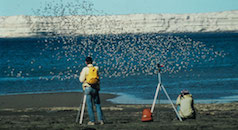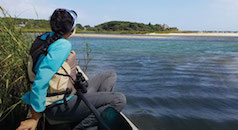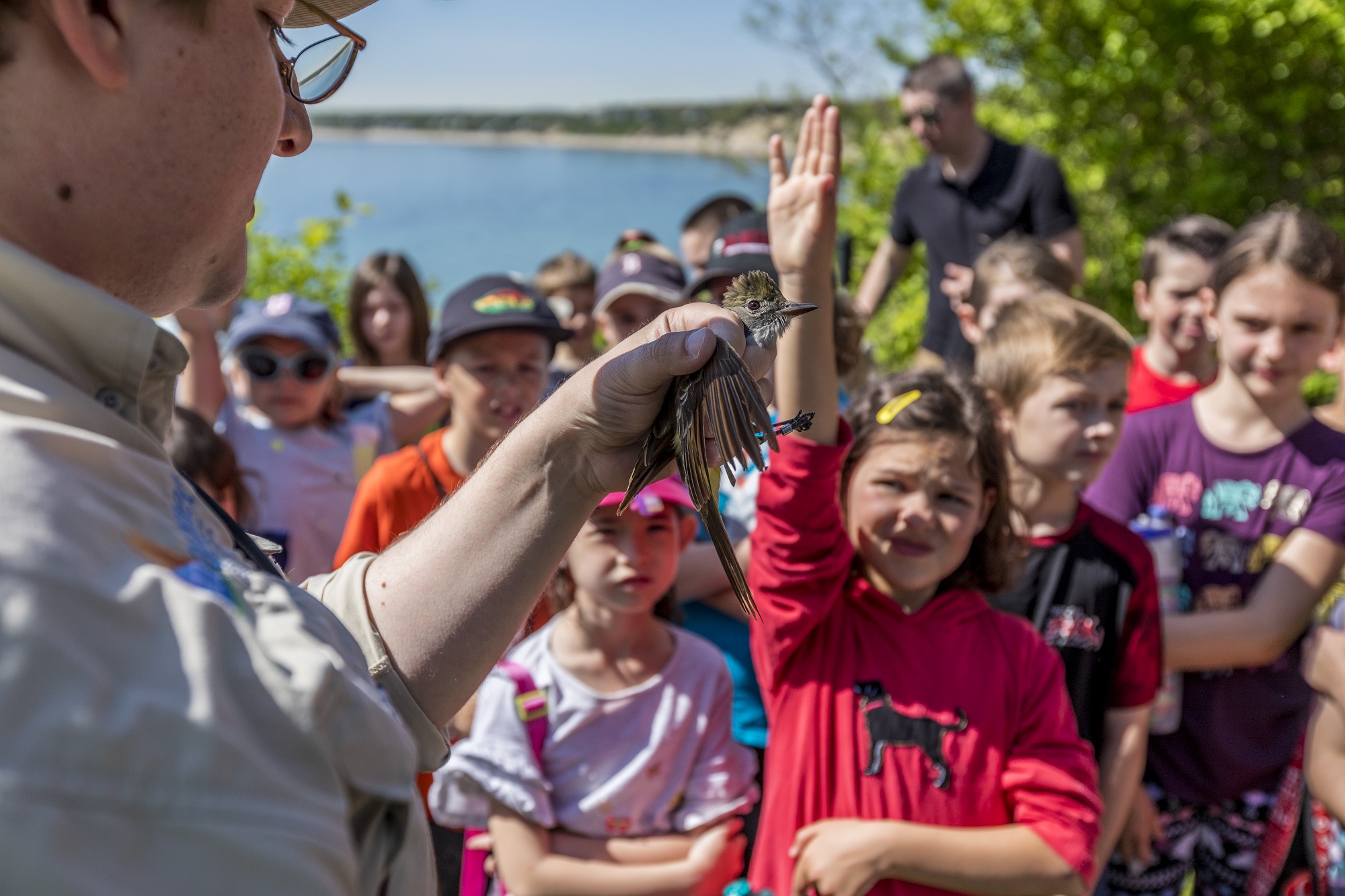Populations
Each fall, North American monarchs travel from their summer breeding grounds to overwintering locations. ⛰️🦋East of the Rocky Mountains, monarchs travel up to an astonishing 3,000 miles to central Mexico, whereas the shorter migration 🦋⛰️west of the Rockies is to the California coast. There is evidence of some interchange between the eastern and western populations, perhaps when individuals cross the Rocky Mountains, when butterflies fly from the western U.S. to the Mexican wintering sites, or when butterflies from the Mexican sites fly into the western U.S.
In addition to the eastern and western populations, a small non-migratory population has long inhabited southern Florida🦋🌴. While some eastern migratory monarchs pass through Florida during their migration, the resident population receives an annual influx of individuals from the eastern population in the fall.
Migration
Four or five generations of monarchs complete their life cycle in a year. Summer breeding populations of monarch butterflies only live for 2-6 weeks. They travel shorter distances while mating and laying eggs. The final generation of the summer, called the super generation, can live for nine months, allowing them to migrate from their summer habitat to overwintering sites in Mexico or California. To extend their life and conserve enough energy to survive a long journey, migrating monarchs undergo reproductive diapause, which means their reproductive abilities are delayed until the following February or March, when they leave their overwintering sites and the annual cycle begins again.
To learn more, visit https://monarchjointventure.org/monarch-biology/monarch-migration
Monarch Life Cycle
Female monarchs lay eggs on their host plant, milkweed. Once the eggs hatch, caterpillars rely on the host plant for food and shelter. Caterpillars are constantly eating and growing. They will reach 2,000 times larger than their original size before they form a chrysalis! When a monarch forms the chrysalis, it will undergo a complete metamorphosis. When the monarch emerges from its chrysalis, it spends a few hours drying its wings and pumping fluids into them. It then looks for its first food source. At this stage, monarchs rely on nectar-rich sources to fuel them for mating or migration.🥚🌱➡️🐛➡️🍐➡️🦋
Learn more about the monarch life cycle at https://monarchjointventure.org/monarch-biology/life-cycle
Instars
Under average summer temperatures, monarchs’ larval stage lasts nine to fourteen days. As the caterpillar grows and becomes too large for its skin, it molts or sheds its skin. The intervals between molts are referred to as instars. Monarch larvae have five instars, each with distinct characteristics to help distinguish them.
Learn more at https://monarchjointventure.org/monarch-biology/life-cycle#guide
Threats to Monarchs
Monarchs face significant threats, leading to declining North American populations. Significant impacts include habitat loss for breeding, migrating, and overwintering; indiscriminate use of chemicals harming monarchs; climate change making habitats unsuitable and altering migratory patterns; and risks from predators, parasitoids, and diseases.
Anyone can take simple actions to support migratory monarchs: Plant native milkweed and nectar sources, report observations to community science programs, reduce pesticide use, educate yourself and others, advocate for conservation initiatives in your community, and contribute financially to conservation efforts.
Learn more about how you can get involved at https://monarchjointventure.org/get-involved
Learn more about the threats monarchs face at https://monarchjointventure.org/threats
OE
Ophryocystis elektroscirrha (OE) is a debilitating parasite that infects monarchs and a few related species. Infected adult monarchs harbor many thousands of microscopic OE spores on the outside of their bodies. When dormant spores are scattered onto eggs or milkweed leaves by infected adults, monarch larvae consume the spores, and these parasites then replicate inside the larvae and pupae, spreading the infection. Monarchs with severe OE infections may fail to emerge successfully from their pupal stage or emerge with difficulties, causing malformed wings. Monarchs with mild OE infections can appear normal but exhibit decreased fitness, resulting in shorter lifespans and reduced reproductive capacity.
Learn more about OE at https://www.monarchparasites.org/
ESA Listing Status
In December 2024, the U.S. Fish and Wildlife Service (USFWS) proposed listing the monarch butterfly as threatened under the Endangered Species Act (ESA), along with a 4(d) rule and proposed critical habitat protections. This follows a decade-long review process that began with a formal petition in 2014.
After a 90-day public comment period (Dec 2024–Mar 2025), the USFWS reopened the comment period for an additional 60 days, which ended on May 19, 2025. They’re now reviewing all submitted comments, scientific data, and stakeholder feedback.
👉 What’s next?
USFWS has until December 2025 to finalize its decision. The monarch could be officially listed as threatened, endangered, or not listed, and if listed, protections would follow—including a finalized 4(d) rule that could allow for flexible conservation actions.
While this decision is pending, monarchs continue to face habitat loss, climate change, and pesticide exposure. Listing under the ESA is one key step—but conservation action at all levels is essential.
Learn more about the legal status of monarchs at https://monarchjointventure.org/status
Create Pollinator Habitat
One of the best things you can do for monarchs and pollinators is to plant pollinator habitat. Even a few plants can make an impact! Below is a quick guide to planting pollinator gardens.
Step 1: Picking a Site
☀️Choose a sunny spot
🍃 Include windbreaks
🌱Prepare the soil and note your soil type
Step 2: Selecting Your Plants
🌻Find nurseries that sell native, untreated plants
💐Aim for high species diversity with diverse shapes, colors, heights, and bloom periods.
🐛 Include larval host plants (milkweed for monarchs)
Step 3: Planting the Garden
🗺️First, develop a plan that outlines the number of plants needed, any additional features (such as a path or bench) to include, and the necessary equipment. Grouping plants by species can provide large splashes of color that are attractive to butterflies.
🌼For plugs: Keep plants well-watered before and after planting. When ready to plant, dig a hole large enough for the plug’s roots. Use soil to cover the roots, leaving only the plant’s leaves and stem above ground. Add straw or grass mulch around the plants to retain water in the soil and prevent weed growth. Water newly planted plugs.
🌱For seeds: Most native seeds are distributed naturally at the soil surface, so they only need to be raked in or planted shallowly. Direct seed-to-soil contact is most important. In some regions, native species require cold, moist stratification or exposure to winter-like conditions. Planting or spreading seeds in the late fall or winter can be an effective strategy. If planting in the spring, plant after the risk of frost has passed.
Step 4: Maintenance
💧 Water plants until they are well-established.
🌿Control the weeds.
🐝🐞 🐦 Enjoy your hard work!
Natives & Cultivars & Nativars, oh my!
Natives & Cultivars & Nativars, oh my! Selecting plants for your pollinator habitats can be both fun and exciting, but it can also be confusing. What are natives, cultivars, and nativars, and what’s the difference?
Native plants occur naturally in a particular region, state, ecosystem, and habitat without human actions. Cultivars are plants intentionally selected and bred for specific traits, including color, height, sturdiness, drought tolerance, etc. With the genetic modifications from natives, cultivars may not supply enough nectar, pollen, or seeds to support the amount of life native species would. In addition, if the colors and shape of the cultivar are different from the original native species, pollinators are less likely to be drawn to the cultivar. Nativars is another term for cultivars, but the original species used were native to the area. Nativars have the same potential not to provide nectar or pollen.
To identify a cultivar or nativar at the store, check to see if it has a cultivar name. For example, the photo in this post is of a cultivar of Large-flowered tickseed (coreopsis grandiflora) called Sunkiss Coreopsis. The label displays the scientific name with “SunKiss” in quotation marks. Another way to tell if a plant is a cultivar is if its name has a trademark (™) or registered symbol (®).
*Remember, any habitat is almost always better than no habitat. Native species are the best option, but we also recognize the limitations of available resources.
Agriculture
The monarch butterfly population is in decline due to the loss of habitat, including its host plant, milkweed! Increasing pollinator habitat in agricultural areas is key to restoring monarch populations. Agricultural lands are rich with opportunities to support monarch habitats, from fallow fields, hedgerows, marginal cropland, field margins, and the yards and gardens around our homes. Native prairie or grassland plantings for monarchs can also be incorporated into farm buffer systems (such as filter strips, grassed waterways, roadside embankments, and septic drainage fields). Even without installing new habitats, many ways exist to support healthier monarch populations in agricultural areas. Identifying and protecting existing habitat areas from mowing or potential pesticide drift are simple actions to promote monarch recovery.
Learn how you can support pollinators on agricultural lands at https://monarchjointventure.org/get-involved/who-are-you/agricultural-producer
Community Science
To understand monarch migration, we rely on community scientists (also called citizen scientists) to collect data during all phases of the annual life cycle of monarch breeding, migrating, and overwintering. While measuring and studying overwintering colonies may provide the best estimate of population size, it is also important to gain insight into breeding population trends and factors influencing migration within the U.S.
Learn more about monarch community science programs and how you can get involved at https://monarchjointventure.org/community-science




